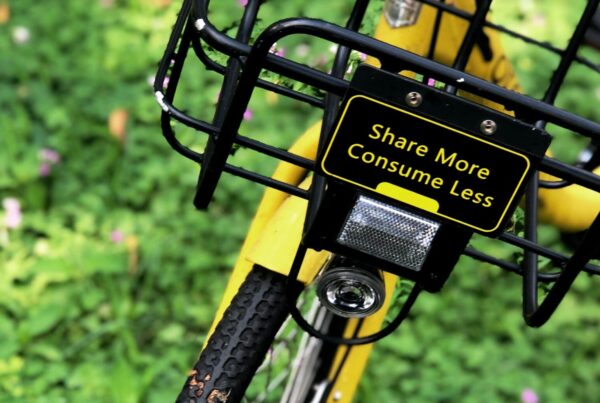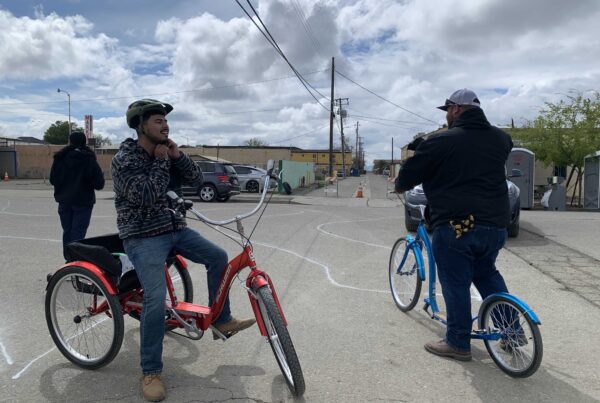On a rainy April morning, a troupe of harlequin-costumed figures gathered around a private shuttle picking up Google employees at a bus stop on San Francisco’s 24th Street.
A woman wearing faux Google Glasses began handing out fake bus tickets that would allow all residents to ride the tech company’s private shuttles, while her compatriots performed a series of choreographed dance moves in the street that prevented the vehicle from departing.
The demonstration marked just one (especially colorful) example of the ongoing protests over the “Google buses” that use Muni bus stops to pick up and transport San Francisco-based tech workers to and from their jobs in Silicon Valley.
While San Francisco’s protests are also largely driven by concerns over gentrification and skyrocketing housing prices in the Bay Area, conflicts over use of street space are taking place in communities across North America, as more and more cities find that there’s simply not enough curb to go around.
The Fight over Street Space
Urban streets are becoming home to an increasingly diverse collection of transportation modes, including private autos, taxis, buses, streetcars, bikes, delivery trucks and carshare and ridesourcing vehicles. Meanwhile pedestrians are also staking a greater claim, as streets become enlivened public spaces, featuring plazas, parklets and places for community gatherings.
To deal with this evolution, some cities have shifted to a new model of planning that prioritizes active streets through measures such as Transit Oriented Development and protected bike lanes. But it’s not always easy to manage competing interests, and cities must now work harder than ever to keep control over their public thoroughfares.
In San Francisco’s case, residents had become increasingly frustrated with the fleets of tech buses that descended on the city, illegally using public bus stops, loitering in bike lanes and further obstructing the city’s overcrowded streets. Instead of shutting down the shuttles, however, the San Francisco Municipal Transportation Agency (SFMTA) opted to launch a pilot project to manage and evaluate them, and in doing so provided a template for other cities to consider.
Wrangling Tech Buses
The SFMTA commenced its 18-month Commuter Shuttle Pilot Program in August 2014, with the goal of minimizing the negative impacts of the shuttles while offering some kind of framework to manage their operation. The agency realized that its lack of guidelines had resulted in confusion for shuttle operators and neighborhood residents, inconsistent enforcement and real and perceived conflicts with other transportation modes.
Central to the pilot was the creation of a limited network of shared Muni and commuter shuttle stops throughout the city. To use the network, shuttle service providers had to apply for a permit and pay a fee of $3.67 per stop-event (as of Fiscal Year 2016). Meanwhile, the program was enforced by the SFMTA to ensure that shuttle operators followed all rules and regulations outlined in the pilot.
The pilot’s stop locations were proposed by operators and underwent SFMTA evaluation and public review. These “Shuttle Zones” were located throughout the city, but mainly on major arterial networks designated by the SFMTA (you can view the full map here).
Additionally, the program also allowed SFMTA to collect data showing the movement and usage of the shuttles. Based on this information, the agency was able to conduct a comprehensive evaluation in late 2015 showing how the pilot program performed against its objectives.
SFMTA Evaluation Report Findings
The SFMTA’s report, released in October 2015, found that the program had successfully reduced Muni bus delays, kept shuttles off narrow residential streets and improved pedestrian and bicycle safety. More importantly, it suggested that the tech shuttles helped to reduce single-occupancy vehicle trips and mitigate traffic congestion in the San Francisco area.
In all, the evaluation found that the private shuttles experience roughly 17,000 boardings on average each weekday, and together help remove nearly 4.3 million vehicle miles traveled from the streets each month. Other key findings include:
- 45 percent of SFMTA survey respondents who do not own cars cited shuttles as the “main reason” they did not own one.
- If the shuttles were not an option, nearly half of survey respondents said they would drive alone to work, which would translate to almost 8,000 more one-way car trips per day.
- On a per-stop basis, instances of shuttles blocking Muni buses decreased by 35 percent during the pilot. Less than 3 percent of total shuttle stop-events resulted in blocked Muni buses
While the SFMTA’s commuter shuttle pilot still didn’t please everyone, its success convinced the agency to authorize a one-year program informed by the pilot. And, it serves as a notable example for other cities searching for innovative ideas to control their street space and manage competing public and private interests.
For more information on best practices that cities can use to scale shared mobility, be sure to stay tuned for the launch of SUMC’s Shared Mobility Toolkit and the release of the full Transit Cooperative Research Program report on Shared Mobility and the Transformation of Public Transit later this spring.
Photo credit: Chris Martin



